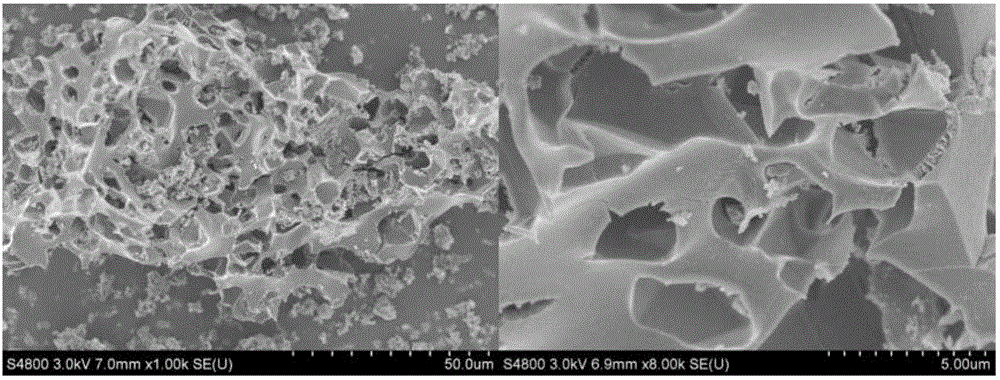Preparation method for three-dimensional hierarchical porous biomass carbon negative electrode material of lithium ion battery
A lithium-ion battery, graded porous technology, applied in battery electrodes, secondary batteries, circuits, etc., can solve the problems of complex preparation process and long time of biomass carbon, and achieve the effect of improving electrochemical performance.
- Summary
- Abstract
- Description
- Claims
- Application Information
AI Technical Summary
Problems solved by technology
Method used
Image
Examples
Embodiment 1
[0016] Embodiment 1: A preparation method of a three-dimensional hierarchical porous biomass carbon lithium ion battery negative electrode material,
[0017] Step 1: Wash and dry the fungus with deionized water, and grind the dried fungus through a 50-mesh nylon sieve to obtain fungus particles with uniform particle size;
[0018] Step 2: using 98% concentrated sulfuric acid to prepare sulfuric acid solution A with a mass fraction of 15%;
[0019] Step 3: Put 1g of fungus particles into 60ml of solution A, stir magnetically for 10 minutes, transfer to the reaction kettle and seal it, set the microwave hydrothermal reaction temperature to 120°C, react for 3 hours, and cool naturally to room temperature to obtain precursor B;
[0020] Step 4: Precursor B is centrifuged and washed with potassium hydroxide solution and deionized water, and then dried;
[0021] Step 5: Put 0.2g of the dried precursor B into 70ml of 0.1M potassium hydroxide solution, stir it magnetically for 12 hou...
Embodiment 2
[0024] Embodiment 2: a preparation method of a three-dimensional hierarchical porous biomass carbon lithium ion battery negative electrode material,
[0025] Step 1: Wash and dry the fungus with deionized water, and grind the dried fungus through a 50-mesh nylon sieve to obtain fungus particles with uniform particle size;
[0026] Step 2: using 98% concentrated sulfuric acid to prepare sulfuric acid solution A with a mass fraction of 20%;
[0027] Step 3: Put 2 g of fungus particles into 65 ml of solution A, stir magnetically for 15 minutes, transfer it into a reaction kettle and seal it, set the microwave hydrothermal reaction temperature to 140°C, react for 4 hours, and naturally cool to room temperature to obtain precursor B;
[0028] Step 4: Precursor B is centrifuged and washed with potassium hydroxide solution and deionized water, and then dried;
[0029] Step 5: Take 0.3g of dried precursor B and put it into 100ml of 0.15M potassium hydroxide solution, stir it magnetic...
Embodiment 3
[0032] Step 1: Wash and dry the fungus with deionized water, and grind the dried fungus through a 50-mesh nylon sieve to obtain fungus particles with uniform particle size;
[0033] Step 2: using 98% concentrated sulfuric acid to prepare sulfuric acid solution A with a mass fraction of 25%;
[0034] Step 3: Put 3 g of fungus particles into 70 ml of solution A, stir magnetically for 20 minutes, transfer to a reaction kettle and seal it, set the microwave hydrothermal reaction temperature to 160°C, react for 5 hours, and naturally cool to room temperature to obtain precursor B;
[0035] Step 4: Precursor B is centrifuged and washed with potassium hydroxide solution and deionized water, and then dried;
[0036] Step 5: Take 0.25g of dried precursor B and put it into 85ml of 0.2M potassium hydroxide solution, stir magnetically for 16h, then vacuum filter, wash with hydrochloric acid solution and deionized water, and dry to obtain activated precursor C ;
[0037] Step 6: Put the ...
PUM
 Login to View More
Login to View More Abstract
Description
Claims
Application Information
 Login to View More
Login to View More - R&D Engineer
- R&D Manager
- IP Professional
- Industry Leading Data Capabilities
- Powerful AI technology
- Patent DNA Extraction
Browse by: Latest US Patents, China's latest patents, Technical Efficacy Thesaurus, Application Domain, Technology Topic, Popular Technical Reports.
© 2024 PatSnap. All rights reserved.Legal|Privacy policy|Modern Slavery Act Transparency Statement|Sitemap|About US| Contact US: help@patsnap.com








